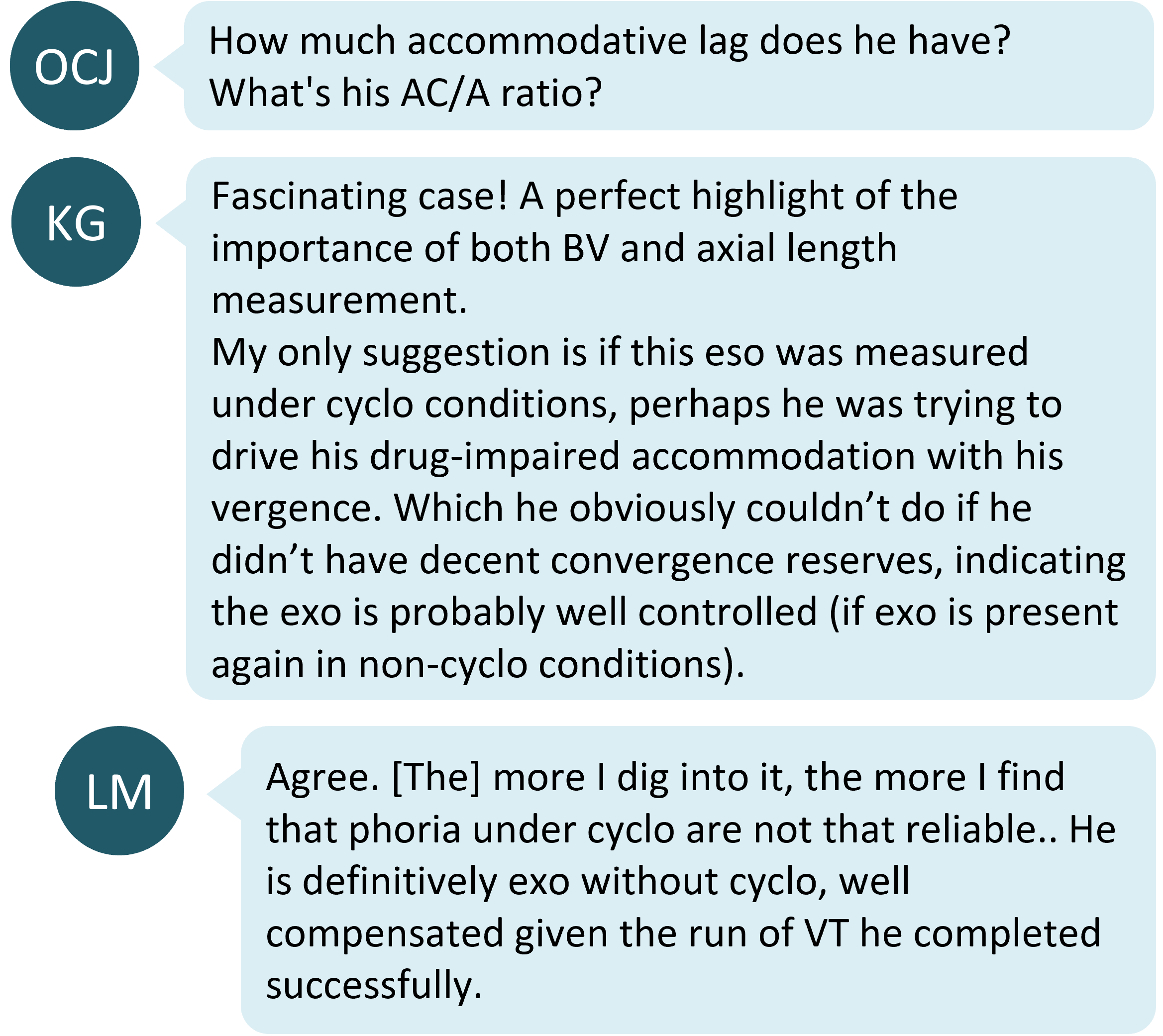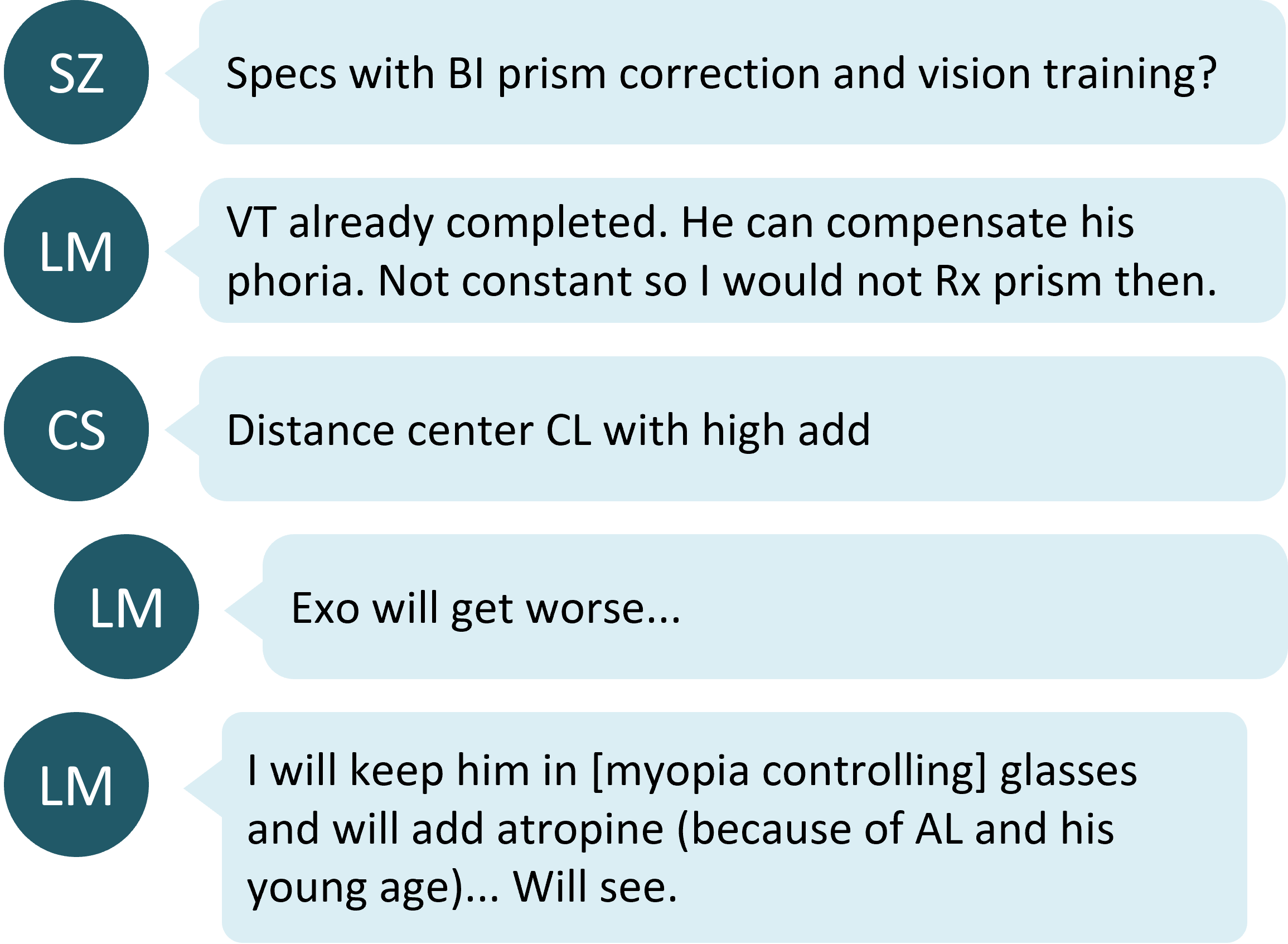The use of cycloplegic agents may be employed in examining myopic children to ensure the most accurate refraction possible.1 What does a cycloplegic agent do to binocular vision function? Typically, under these conditions we would expect a less minus refraction, and at near a reduced or absent accommodation response and a likely exophoric shift. However, LM presented this fascinating case where a patient with a history of exophoria exhibited a significant esophoric shift under cycloplegia. Here is the case.

What could be happening?

The IMI Clinical Management Guidelines suggest that, when cycloplegia is used, to instill two drops of 1% tropicamide or cyclopentolate, given 5 minutes apart.1 In younger children especially, the accuracy of autorefraction is improved with cycloplegia.2
Why is there an esophoric shift with a cycloplegic agent?
Lyu et al found an increase in esodeviation under cycloplegia in 34 Korean children with hyperopia and esotropia.3 The cycloplegic agent used was a mix of 0.5% tropicamide and 0.5% phenylephrine. The authors proposed two explanations. Firstly, a decrease in fusional divergence effort may occur, as patients experience blurred vision due to cycloplegia and stop attempting fusion. This could make sense for children with pre-existing esodeviation, but could apply less to this case where the child has a history of significant exodeviation.
The second explanation was that the 0.5% tropicamide and 0.5% phenylephrine combination has been reported as insufficient to achieve complete accommodation paralysis in children with darkly pigment irides and high amplitude of accommodation.4,5 Hence a young patient may attempt to accommodate to overcome the near blur under incomplete cycloplegia and by doing so, drive more convergence.
Low-dose atropine and esophoric shifts
Myopia management for exophores

When considering spectacle and contact lens options for myopia control, spectacles can be more beneficial for exophores as shifting from spectacles to contact lenses in myopia creates an exophoric shift.10 When myopes view at near with spectacles, they experience base-in prism and less accommodation demand due to off-axis spectacle lens effects. These effects don't exist when viewing at near in contact lens wear, requiring increased convergence and accommodative effort by comparison. In patients with normal binocular vision function this may be inconsequential, but for some the resultant exophoric shift and increase in accommodative lag could cause difficulty.
Even though this child has reportedly well controlled exophoria, his binocular vision history led his eye care practitioner LM to preference myopia controlling spectacles. Read more in this clinical article What About the Exophores?
Is there value in measuring binocular vision under cycloplegia?
While cycloplegia may reveal the ‘true’ refractive state, it may not necessarily give us a picture of the true binocular vision state when accommodation is active. The dynamic binocular visual system can compensate when accommodation is influenced by partial or full cycloplegia, leading to unexpected alteration in vergence function.
At baseline, prior to cycloplegia and on follow-up examinations, this case study and the literature confirm the importance of measuring binocular vision function to assess for any impacts due to low-dose atropine treatment.1
Take home messages:
- Cycloplegic agents may result in an esophoric shift due to the binocular vision system attempting to overcome near blur by driving excessive convergence.
- Exophores can benefit from myopia controlling spectacles, which have less accommodative and vergence demand at near compared to when wearing contact lenses.
- It is important to check the binocular vision status of a child who is being treated with low-dose atropine.
Further reading

About Kimberley
Kimberley Ngu is a clinical optometrist from Perth, Australia, with experience in patient education programs, having practiced in both Australia and Singapore.

About Connie
Connie Gan is a clinical optometrist from Kedah, Malaysia, who provides comprehensive vision care for children and runs the myopia management service in her clinical practice.
This content is brought to you thanks to an unrestricted educational grant from
![]()
References
- Gifford KL, Richdale K, Kang P. et al IMI – Clinical Management Guidelines. Invest Ophthalmol Vis Sci 2019;60:M184-M203. (link)
- Hashemi H, Khabazkhoob M, Asharlous A, Soroush S, Yekta A, Dadbin N, Fotouhi A. Cycloplegic autorefraction versus subjective refraction: the Tehran Eye Study. British journal of ophthalmology. 2016 Aug 1;100(8):1122-7. (link)
- Lyu IJ, Park KA, Oh SY. Increase in esodeviation under cycloplegia with 0.5% tropicamide and 0.5% phenylephrine mixed eye drops in patients with hyperopia and esotropia. BMC ophthalmology. 2017 Dec;17(1):1-5. (link)
- Fan DS, Rao SK, Ng JS, Yu CB, Lam DS. Comparative study on the safety and efficacy of different cycloplegic agents in children with darkly pigmented irides. Clin Experiment Ophthalmol. 2004;32:462–467. (link)
- Nishizawa AR, Orton RB, Cadera W. Comparison of 0.5% cyclopentolate plus 0.5% tropicamide and 1% cyclopentolate alone for mydriasis of dark irides. Can J Ophthalmol. 1988;23:299–300. (link)
- Nishizawa AR, Orton RB, Cadera W. Comparison of 0.5% cyclopentolate plus 0.5% tropicamide and 1% cyclopentolate alone for mydriasis of dark irides. Can J Ophthalmol. 1988;23:299–300. (link)
- Jahan S, Kothari M, Solanki M. Treatment of 0.01% atropine eye drops induced convergence excess esotropia and rebound myopia managed with 1% atropine eye drops. Indian Journal of Ophthalmology-Case Reports. 2021 Jan 1;1(1):140. (link)
- Kothari M, Modak M, Khan H, Jahan S, Solanki M, Rathod V. Convergence excess consecutive esotropia associated with 0.01% atropine eye drops usage in patients operated for intermittent exotropia. Indian Journal of Ophthalmology. 2020 Apr;68(4):653. (link)
- Yam JC, Jiang Y, Tang SM et al. Low-Concentration Atropine for Myopia Progression (LAMP) Study: a randomized, double-blinded, placebo-controlled trial of 0.05%, 0.025%, and 0.01% atropine eye drops in myopia control. Ophthalmol 2019;126:113-24. (link)
- Hunt OA, Wolffsohn JS, Garcia-Resua C. Ocular motor triad with single vision contact lenses compared to spectacle lenses. Cont Lens Anterior Eye 2006;29:239-245. (link)











